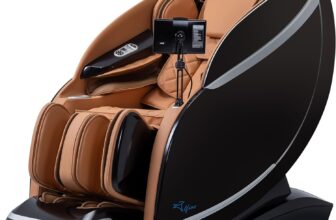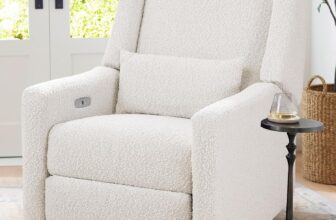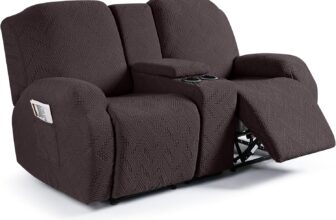4 Best Wall Hugger Loveseat Recliners for RVs in 2026
Recliners Guide is reader-supported. As an Amazon Associate, I earn from qualifying purchases. Learn more about our process here.
The wall hugger loveseat recliners have some of the tremendous benefits that usual recliners do not have. First off, in order to fully recline, they do not require a lot of space from behind, thus making them one of the most sought-after ‘against the wall’ recliners. Typically, a wall hugger double recliner needs just about 3-4 inches clearance from the wall, which is great. This way, the couch tends to consume less space and fit in perfectly in motorhomes, RVs or other tight spaces. Let’s find out some of the best tufted loveseat in the market.
4 Best Wall Hugger Loveseat Recliners for RVs in 2025
(1) RecPro Charles 67″ Double Recliner RV Sofa
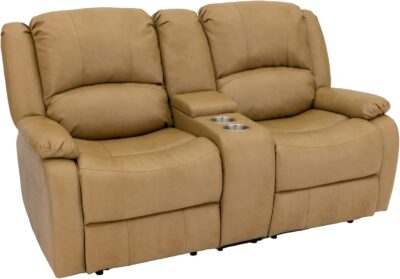
first hand user review “I also love that the lounging handles are on the inside of the armrest and not on the lower outside of the sofa. You don’t even have to barely move to get into the lounging position. You have the hand pull right next to you.” — Krisley
The Double Recliner RV Sofa is almost entirely up to your expectations one that’ll complement your overall limited furniture in your RV. Although this is ideal for placing in your RV you can also set it in your living room. The recliner has a robust built, simple yet beautiful design, very comfortable, and not to mention the 3-inch clearance space that it takes from the wall.
Beside RVs you can definitely check it out for your Bunkhouse if you have one. It’s also easy to put together but the only probable downside is that the recliner doesn’t come with the documentation or manual. It’s cozy and spacious that you can sleep on it.
(2) RecPro Charles 58″ Powered Double RV Wall Hugger Recliner
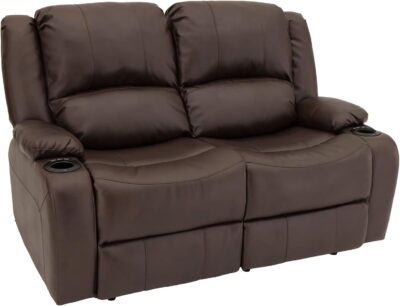 The Powered Double RV Wall Hugger Recliner is a space saving loveseat recliner and it’s an extremely ideal choice for those who fancy keeping one in their RVs. Unlike most other recliners, this one comes with built in USB charger. The assembly isn’t that much of a struggle and so is the installation.
The Powered Double RV Wall Hugger Recliner is a space saving loveseat recliner and it’s an extremely ideal choice for those who fancy keeping one in their RVs. Unlike most other recliners, this one comes with built in USB charger. The assembly isn’t that much of a struggle and so is the installation.
- It reclines independently.
- You can turn off the cup holder light by a push button.
- The soft fabric of the recliner makes it easy to clean.
- Built in USB charger.
- Easy assembly.
(3) RecPro Charles Powered Double RV Wall Hugger Recliner
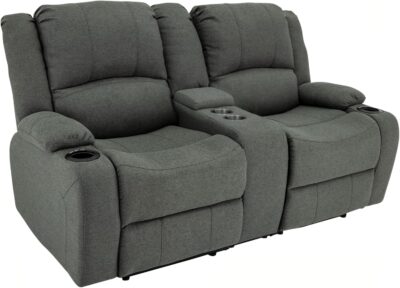 The Powered Double RV Wall Hugger Recliner is a beautiful looking furniture one that can definitely enhance the overall ambiance of your RV. Your elderly grandparents can also use it in a way they want for the recliner reclines with the touch of a button. It has a decent size for it can easily get through your RV door but it’s not that small so you feel like less space i.e. neither too small nor too big. The cupholders have blue LED light. It will last years and is the perfect choice for the year 2021. The recliner is upholstered with soft cloth that doesn’t make the recliner too hot in summer.
The Powered Double RV Wall Hugger Recliner is a beautiful looking furniture one that can definitely enhance the overall ambiance of your RV. Your elderly grandparents can also use it in a way they want for the recliner reclines with the touch of a button. It has a decent size for it can easily get through your RV door but it’s not that small so you feel like less space i.e. neither too small nor too big. The cupholders have blue LED light. It will last years and is the perfect choice for the year 2021. The recliner is upholstered with soft cloth that doesn’t make the recliner too hot in summer.
- Outstanding physical appearance and color.
- Reclines with the touch of a button.
- Sturdy structure.
- Soft cloth one that can be cleaned easily.
- Neither too big nor too small.
(4) Thomas Payne 68″ Tri-Fold RV Sofa in Majestic Chocolate
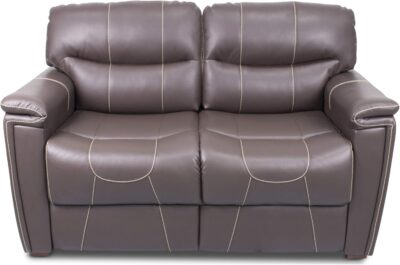
first hand user review “Very comfortable for sleeping on when folded out. Perfect for 1 adult or 2 children.“ —KD
The Thomas Payne recliner is a top notch choice for RV drivers. It isn’t only durable and lightweight the recliner is way too comfortable to have short nap on. Although there is no installation guide the assembly seems to be pretty straightforward. It’s more than just a couch one that can give you a comfort you need during the hectic day and night. It’s a lightweight furniture so you can place wherever you wish to inside your RV.
Choosing the Best Wall Hugger Loveseat Recliners for RVs
1) Space and Dimensions
A good rule of thumb is to measure your RV space twice: once for the footprint of the furniture in its closed position, and again with the recliner fully extended. Some older models require nearly a foot of clearance from the wall, which is just not practical in an RV. That’s where modern wall-hugger designs really shine. Many need just two to four inches of space to recline fully, making them game-changers compared to the bulky recliners of the past.
Width is another factor people often overlook. A “loveseat” sounds compact, but they can range anywhere from 50 inches to over 70. If your RV has a narrow slide-out, shaving just a few inches can make the difference between a smooth fit and a daily frustration. I’ve found that the slimmer builds still feel generous once you’re sitting down, thanks to smarter armrest and cushion design.
Height matters too—especially if you’re taller or shorter than average. Some recliners sit surprisingly low, which can make getting up harder, particularly for anyone with joint issues. On the flip side, higher-seated models feel closer to what you’d expect in a home recliner and don’t sacrifice support.
2) Wall Clearance
If there’s one detail that can make or break your RV recliner choice, it’s wall clearance. RVs aren’t exactly known for their generous living space, and every inch matters. Traditional recliners often need 10–12 inches of room behind them to fully extend, which in a compact RV feels almost impossible. That’s why wall-hugger designs have become so popular—they’re engineered to slide forward on their track as they recline, meaning you only need about 2–4 inches between the chair and the wall.
When I first upgraded from an older “standard” recliner to a wall-hugger loveseat, the difference was night and day. Suddenly, I wasn’t constantly bumping the wall or rearranging the space just to kick back. It also freed up room for walking paths, which is a bigger deal than you realize until you’ve lived with furniture that eats into your aisle space.
Another thing to think about is how the recliner clears nearby cabinetry, windows, or slide-outs. Even if the back doesn’t hit the wall, you’ll want to double-check that the footrest doesn’t jut into other furniture or block drawers when extended. Some manufacturers publish the “open depth” (from the wall to the edge of the footrest when fully reclined), and that’s a measurement worth paying attention to.
In an RV, wall clearance isn’t just about making the chair fit—it’s about keeping your whole layout functional. Choosing a true wall-hugger recliner means you can enjoy the comfort of stretching out without sacrificing precious space. For me, that small design upgrade felt like a huge quality-of-life improvement on the road.
3) Weight and Installation
One thing I didn’t fully appreciate until I bought my first RV recliner was just how important weight is. Unlike at home, every pound you add to your RV affects fuel efficiency, balance, and even how smoothly your rig drives. A standard residential loveseat recliner can easily tip the scales at 180–200 pounds—great for stability in a living room, but not ideal when you’re hauling it in and out of a travel trailer. RV-specific wall-hugger loveseats are typically much lighter, often in the 120–150 pound range, and some even come in modular pieces to make them easier to carry through a narrow doorway. That’s a big plus when you’re squeezing furniture through a 26-inch RV entry.
Installation is usually straightforward, but it’s not as “plug-and-play” as the brochures sometimes suggest. Many recliners come in two or three parts (back, base, and sometimes armrests) that slide or bolt together once inside. The first time I installed mine, I underestimated how tricky it would be to angle the base through the door—so a second set of hands really helped. Once inside, assembly took less than 30 minutes.
Another thing worth noting: some loveseats bolt directly to the RV floor for safety during travel. If yours does, be prepared with basic tools and to possibly drill into the subfloor. It sounds intimidating, but in practice, the manufacturers usually line up the anchor points pretty well.
4) Comfort & Cushioning
At the end of the day, comfort is why you’re even looking at a wall-hugger loveseat recliner for your RV. I’ll be honest: I was skeptical the first time I swapped out a traditional sofa for one of these. I thought, “How comfortable can an RV-specific recliner really be compared to the plush ones at home?” To my surprise, it was much closer than I expected.
The cushioning is usually on the firmer side, and that’s actually a good thing in an RV. Softer, overstuffed seats may feel dreamy in a showroom, but after a few hours on the road, they can flatten out and leave you sore. A firmer cushion holds its shape better, and when you’re parked for a long movie night, it supports your back without sagging. For me, lumbar support made all the difference—it’s one of those features I didn’t realize I needed until I had it.
The seat depth also matters. Some loveseats feel shallow, which is fine for shorter folks but leaves taller people sitting “on” rather than “in” the chair. I’d compare it to the difference between an airline seat and a home recliner—you want that balance of support and room to stretch.
5) Material & Durability
When I was shopping for a wall-hugger loveseat recliner for my RV, I kept asking myself one big question: Will this thing actually hold up to the way we live on the road? An RV is not the same as a house—you’ve got temperature swings, tighter spaces, and constant use from long days of lounging. That’s where the material really makes or breaks the purchase.
A lot of RV recliners use what’s called “faux leather” or bonded leather. I’ll admit, I was skeptical at first because I’ve seen cheap versions start peeling after a year. But the better-quality faux leathers are surprisingly tough, easier to clean than real leather, and more resistant to spills—huge when you’ve got kids, pets, or a morning coffee habit. One quick wipe and you’re back in business. Real leather, on the other hand, is gorgeous and ages beautifully, but it needs more care and doesn’t always love the fluctuating humidity in an RV.
Fabric is another option, and while I love the cozy feel, it does stain more easily. If you go fabric, I’d suggest something tightly woven and ideally treated to resist moisture. I once compared two loveseats side by side—one fabric, one faux leather—and while the fabric felt warmer initially, the leatherette clearly looked “new” much longer.
Durability also comes down to what’s under the surface: the frame and mechanics. A sturdy steel or hardwood frame makes a world of difference. I’ve had recliners where the frame felt wobbly after just a season, and others that still feel solid years later. The difference? Materials and build quality.
6) Power vs. Manual Recline
When I was choosing a wall-hugger loveseat recliner for my RV, one of the first decisions I had to make was whether to go with a power recline or stick with manual. Honestly, both have their pros, and which one works best really depends on how you plan to use it.
Power recliners are undeniably convenient. With the push of a button, you can fine-tune the angle until you hit that sweet spot. I like that level of control, especially on long road trips when comfort can be the difference between dozing off in a happy nap or fidgeting endlessly. Power recliners also tend to feel more modern and come with extras like USB ports, which make charging devices easy while lounging. The trade-off? They’re heavier, pricier, and of course, you’re relying on electricity. If something breaks, you’re waiting on parts instead of just tightening a screw.
Manual recliners, on the other hand, win on simplicity. No cords, no motors—just a pull handle or push-back motion. I’ve always found them a little lighter and easier to install, which matters in an RV where weight and space are limited. They’re also less likely to fail over time, and if they do, repairs are usually quick and inexpensive. The downside is you don’t get the same precision in positioning. You’ll usually have a couple of set angles rather than infinite adjustment.
Comparing the two, I’d say power is a luxury that’s nice to have if you don’t mind the extra cost and complexity, while manual is a more practical, no-fuss option. In an RV, where outlets can already be scarce, sometimes simpler really is better. For me, it came down to deciding whether I valued customization over reliability.

